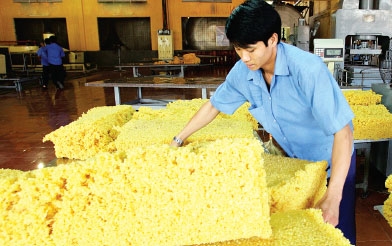VRG looks to bounce back
 In its shake-up plan, the Vietnam Rubber Industry Group (VRG) proposed turning industrial zone (IZs) investment on rubber land to its core business line, as VRG argued this area could bring hefty profits to ensure the group’s future growth.
In its shake-up plan, the Vietnam Rubber Industry Group (VRG) proposed turning industrial zone (IZs) investment on rubber land to its core business line, as VRG argued this area could bring hefty profits to ensure the group’s future growth.
In fact, VRG is managing 13 IZs covering 4,500 hectares. Of them, three IZs with an occupancy rate surpassing 80 per cent report an average return on equity rate of 30 per cent per year, five IZs started generating revenue and profits from 2011 and five remaining IZs began operation from 2011.
VRG argued until 2015 IZ business would continue to be a fast growing area with healthy profits for the group against modest investment costs.
VRG’s proposal seems strange in the context the government demanded state groups and corporations to divest from non-core businesses. Hence, competent government agencies assumed VGR should only invest in those IZs engaged in wood processing and making rubber items and gradually divest from other IZs.
At this time, VRG consists of 168 member units, of them it holds a ruling stake in 115 firms and 48 long-term financial investment companies. The number of member units having a more than 50 per cent stake retained by parent company VRG may swell further in light of the proposed shake-up plan. Accordingly, the group sought to deepen its presence to take ruling in some rubber industry businesses and form some new shareholding firms.
In this respect, a government agency executive suggested VRG hikes stakes in firms deeply involved in production and should not found new IZ trading firms.
VRG is also required to take stronger actions in divestiture commitment since under the proposed plan the group would still hold 35 per cent stake in four hydropower plants, some investment consulting businesses, rural residential block management firms and the rubber finance company.
In respect to long-term financial investments, VRG envisages totally divesting from 46 firms in which it does not hold ruling stake with priority given to firms operating in finance, banking and securities fields. Divestiture from later firms will be realised during 2012-2013.
Under VRG’s proposed plan, the group seeks to achieve an average 15 per cent, per year revenue and profit growth, 22 per cent, per year pretax profit on revenue rate, 24 per cent per year pretax profit on state capital rate, pay VND3.5 trillion ($166 million) to state coffers per year and create 70,000-80,000 new jobs at home and abroad.
What the stars mean:
★ Poor ★ ★ Promising ★★★ Good ★★★★ Very good ★★★★★ Exceptional
Related Contents
Latest News
More News
- Businesses ramp up production as year-end orders surge (December 30, 2025 | 10:05)
- Vietjet chairwoman awarded Labour Hero title (December 29, 2025 | 13:06)
- How to unlock ESG value through green innovation (December 29, 2025 | 10:03)
- AI reshapes media and advertising industry (December 29, 2025 | 08:33)
- FPT and GELEX sign deal to develop blockchain tech for global markets (December 29, 2025 | 08:29)
- Vietnam’s GDP forecast to grow by 9 per cent in 2026 (December 29, 2025 | 08:29)
- Women entrepreneurs are key to Vietnam’s economic growth (December 29, 2025 | 08:00)
- Vietnam's top 500 value-creating enterprises announced (December 27, 2025 | 08:00)
- The PAN Group shaping a better future with ESG strategy (December 26, 2025 | 09:00)
- Masan Consumer officially lists on HSX, marking the next phase of value creation (December 25, 2025 | 13:20)

 Tag:
Tag:





















 Mobile Version
Mobile Version